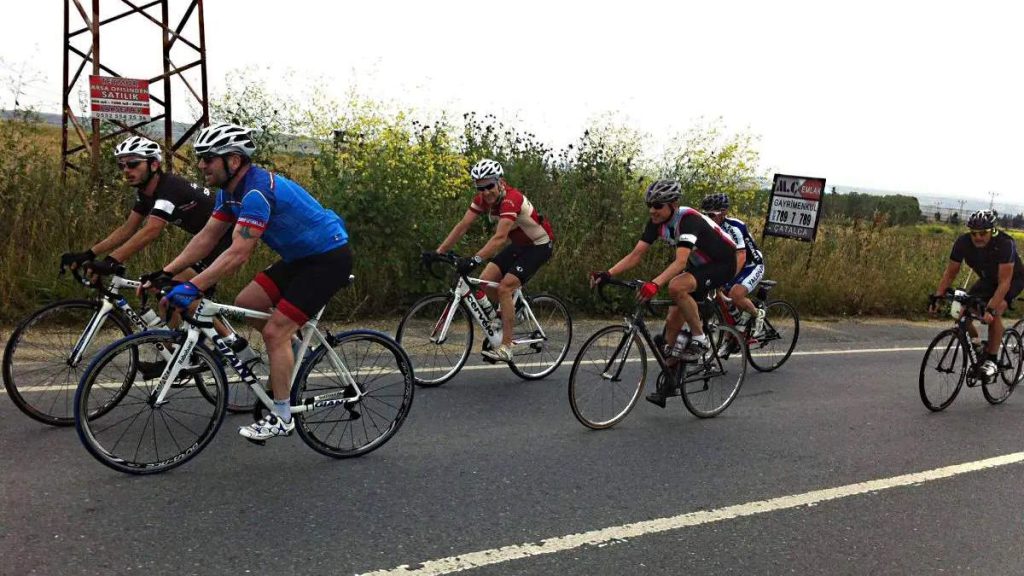In cycling training, Zone 2 refers to a specific intensity range based on your heart rate or power output. It’s part of the five (sometimes seven) training zone systems used by coaches and exercise physiologists to structure workouts.
Definition of Zone 2
- Heart rate based: about 60-70% of your maximum heart rate.
- Power based (FTP system): about 56-75% of your Functional Threshold Power (FTP, see “What is FTP?” title below).
- Perceived effort (RPE scale 1-10): feels like a 3-4/10 effort – you can hold a conversation comfortably while riding.
What It Feels Like
- Breathing is steady and controlled.
- You should be able to talk in full sentences (often called “conversational pace”).
- Legs may feel like they’re working but not burning.
- It’s an endurance pace you can hold for hours.
Purpose of Zone 2 Training
- Builds aerobic endurance: improves your body’s ability to use oxygen efficiently.
- Fat metabolism: teaches your muscles to burn fat as fuel, sparing glycogen for higher efforts.
- Mitochondrial development: stimulates growth of mitochondria in muscle cells, which boosts endurance performance.
- Recovery: Zone 2 rides can also serve as active recovery since the intensity is low enough not to stress the body heavily.
Why Cyclists Use It
- Professional and amateur cyclists spend a large portion of training time in Zone 2 (often 60-70% of total volume).
- It’s the foundation of endurance training – “base miles” are essentially long Zone 2 rides.
- Over time, consistent Zone 2 training makes higher intensities (like climbing or sprinting) more sustainable because your aerobic system is stronger.

What are Other “Zones”?
Zone 1: Active Recovery
- Intensity: <60% of max HR, <55% FTP (Functional Threshold Power, see “What is FTP?” title below).
- Feeling: Very easy, like spinning your legs. You can talk effortlessly.
- Purpose: Recovery, gentle circulation, removing fatigue without adding stress.
- Duration: Short rides or cool-downs.
Zone 3: Tempo
- Intensity: ~70-80% of max HR, 76-90% FTP.
- Feeling: “Comfortably hard.” Talking in full sentences becomes difficult.
- Purpose: Builds muscular endurance, good for long steady efforts (e.g., solo breakaways, long climbs).
- Duration: Often used for 20-90 minute sustained efforts.

Related: Rate of Perceived Exertion (RPE)
Zone 4: Threshold
- Intensity: ~80-90% max HR, 91-105% of FTP.
- Purpose: Improves ability to ride at or near race pace for long stretches (e.g., time trials, long climbs).
Zone 5: VO₂ Max
VO₂ Max: your body’s maximum ability to use oxygen during intense exercise.
- Intensity: ~90-95% max HR, 106-120% FTP.
- Purpose: Boosts aerobic capacity and high-intensity performance; trained with 3-8 min hard intervals.
Zone 6: Anaerobic Capacity
Anaerobic: energy produced without oxygen, relying on glycogen and stored phosphates.
- Intensity: Efforts lasting 30 seconds to ~2 minutes, well above 120% FTP.
- Purpose: Increases short-term power for attacks, steep climbs, or bridging gaps.
Zone 7: Neuromuscular Power
Neuromuscular: fast-twitch muscle activation and nervous system coordination.
- Intensity: All-out sprints (5-15 seconds), maximum effort.
- Purpose: Improves sprinting ability, acceleration, and finishing speed.
What is FTP?
Functional Threshold Power (FTP) is the highest average power a cyclist can sustain for about one hour without fatiguing. It’s measured in watts (your power output on the bike).
- FTP is used as a personal benchmark to set all training zones (percentages of FTP).
- Example: if your FTP is 250 W, then Zone 2 (56-75% FTP) would be about 140-190 W.
- In short: FTP = your “1-hour race pace power,” and it’s the anchor for structured training.
How to measure FTP?
1. 20-Minute Test (most common)
- Warm up thoroughly.
- Ride as hard as you can sustain for 20 minutes.
- Take your average power for those 20 minutes and multiply it by 0.95.
- Example: 20 min average = 263 W → FTP ≈ 250 W.
- Simple, but requires pacing skill. Many find it mentally tough.
2. Ramp Test (progressive)
- Start easy, increase power every minute until you cannot continue.
- FTP is estimated as about 75% of your final 1-minute max power.
- Shorter and easier mentally, but can underestimate FTP for some riders (especially endurance-focused ones).
3. 60-Minute Test (gold standard)
- Ride all-out for a full hour, take your average power.
- This is the true FTP, but very demanding and rarely done outside of labs or races.
4. Field Data from Races/Training
- Sometimes coaches estimate FTP from real-world race files (e.g., a long climb or time trial effort).
- This avoids artificial testing but requires good quality data and experience.
Tip: Most cyclists use the 20-minute test or ramp test because they’re practical and repeatable.
Sources
- “Zone 2 Training for Cyclists: Where Endurance Training Fits in Your Training Plan” on the Trainer Road website
- “Zone 2 Training Transforms Your Fitness and Health – Experts Explain How to Execute It” on the Bicycling website
- “Why Most of Your Rides Should be Easy Zone 2” on Roberto Vukovic’s website
- “Zone 2 Training: Build Your Aerobic Base for Peak Cycling Performance” on Rouvy Blog
- UCI Elite Men Road Race World Champions: The Complete List [1927-2025] - September 28, 2025
- What Is Zone 2 In Cycling? - September 12, 2025
- The Turkish Flag at the Tour de France: Who’s Waving It at the Finish Line? - July 30, 2025
